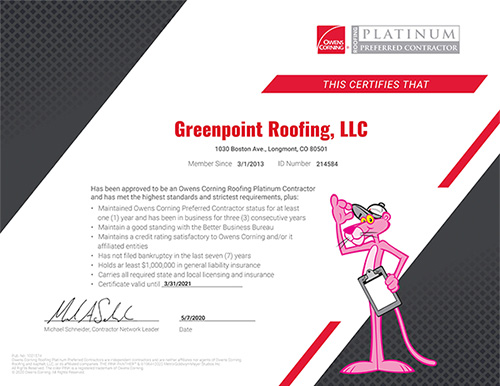Can You Replace Your Roof in Winter?
During warm, dry summer months in the Denver area, many homeowners may think that their roof is in perfect shape. Then fall arrives, bringing snow and rain, and suddenly there’s a leak or shingles that have frozen and begun cracking.
Now what? Can you even replace your roof in winter?
Absolutely. At GreenPoint Roofing, we know that homeowners will choose to get an old roof replaced during the summer, but if necessity requires, the same job can be completed during the winter. In fact, it actually comes with some advantages.
Let’s take a closer look at what happens when you need to replace your roof in winter.
Do Roofing Contractors Work During Winter?
Unlike bears, roofing contractors do not hibernate during the winter. We continue to work all year-round, attending to the customers that need our services.
As we said, it’s not unusual to realize that you have a leak or a problem with your roof until the winter hits. That’s when you’ll start to see moisture entering the home due to rain or snow.
Scheduling a roofing contractor during the winter can also be a lot easier than he summer when the demand is higher. Many roofing professionals even prefer to do specific projects during the winter when the temperatures are not suffocatingly hot.
Of course, if you need to replace your roof in winter, there are disadvantages such as having to reschedule in case of snowy weather, not to mention relatively shorter days. Some roofing jobs are a bit tougher during the winter, so it is a good idea to discuss scheduling and contingencies.
Replacing Your Asphalt Roof
One of the more challenging winter roof replacements are asphalt shingles which can become brittle and difficult to work with during freezing temperatures. In addition, the adhesive that provides a seal between overlapping shingles will not bond sufficiently without the sun’s heat.
To avoid having these shingles coming loose or blowing off your roof shortly after having them installed, it’s best to keep a close eye on the weather. Ideally, asphalt shingles should only be installed when temps are between 40 and 85 degrees.
Flat and Metal Commercial Roofs
For flat roofs, typically commercial roofing, the best type of materials to install during the winter are PVC and TPO (Thermoplastic Olefin). These single ply materials do not require the heat of the sun to bond successfully. They are sealed manually by a roofing professional using a hot air welding technique.
If you want to replace your roof in winter, you may run into trouble if you want a flat rubber roof. These are a challenge to install during the winter months as the adhesives used to fix them to the underlayment may not bond and can result in leaks.
Last but not least, metal roofs are the least affected by cold temperatures, so they can be easily installed during winter.
For help, please contact GreenPoint Roofing in Longmont. We offer in-home consultations and free estimates if you need to replace your roof in winter. We pride ourselves on working with honesty and integrity. Our priority is to provide high quality, long-lasting roofing at the best possible price for both homeowners and businesses.















